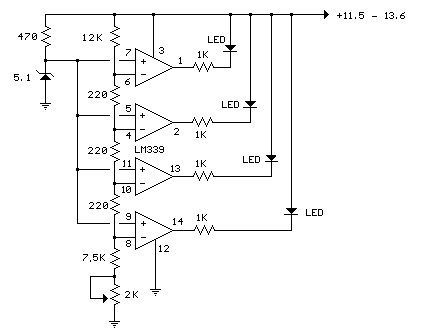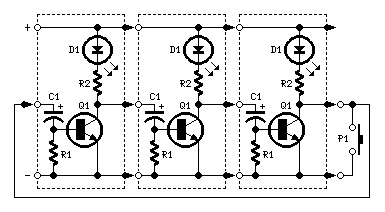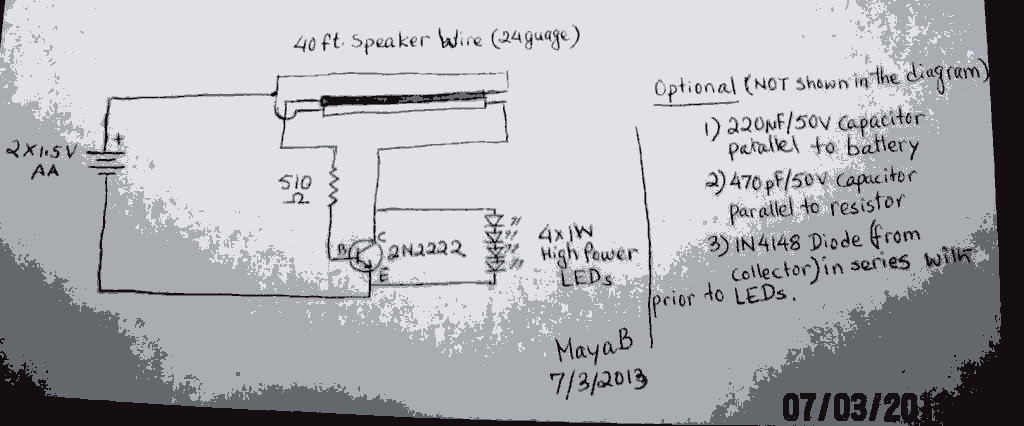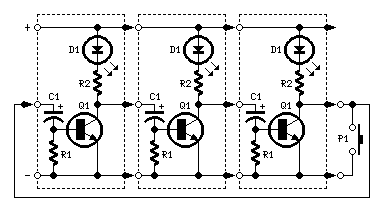
Fading LEDs

This circuit operates two LED strips in pulsing mode, i.e. one LED strip goes from off state, lights up gradually, then dims gradually, etc. while the other LED strip does the contrary. Each strip can be made up from 2 to 5 LEDs at 9V supply. The two Op-Amps contained into IC1 form a triangular wave generator. The rising and falling voltage obtained at pin #7 of IC1 drives two complementary circuits formed by a 10mA constant current source (Q1, Q2 and Q5, Q6) and driver transistor (Q3 and Q6). R4, R5 & C1 are the timing components: the total period can be varied changing their values. R7 & R8 vary the LEDs brightness.
The described circuit utilizes a dual operational amplifier (Op-Amp) configuration within IC1 to generate a triangular wave signal, which is essential for achieving the pulsing effect in the LED strips. The triangular wave oscillation produced at pin #7 of IC1 alternates between a minimum and maximum voltage, effectively controlling the brightness of the LED strips in a complementary manner.
The LED strips, powered by a 9V supply, can consist of 2 to 5 individual LEDs each. The current through the LEDs is regulated by a constant current source formed by transistors Q1, Q2, Q5, and Q6, ensuring that each LED operates within its specified current rating, thus prolonging their lifespan and maintaining consistent brightness. The driver transistors Q3 and Q6 are responsible for amplifying the control signal from the Op-Amp to drive the LED strips.
Timing components R4, R5, and C1 are crucial for determining the frequency and duty cycle of the triangular wave. By adjusting the resistance values of R4 and R5, as well as the capacitance of C1, the total period of the pulsing effect can be modified, allowing for customization of the LED brightness transition speeds. Additionally, resistors R7 and R8 provide further control over the brightness levels of the LED strips, giving the user the ability to fine-tune the visual output according to their preferences.
This circuit design is suitable for applications where dynamic lighting effects are desired, such as in decorative lighting, automotive lighting, or in artistic installations where visual impact is important. The complementary pulsing behavior of the two LED strips creates an engaging visual effect that can enhance the overall aesthetic of the environment in which it is implemented.This circuit operates two LED strips in pulsing mode, i.e. one LED strip goes from off state, lights up gradually, then dims gradually, etc. while the other LED strip does the contrary. Each strip can be made up from 2 to 5 LEDs at 9V supply. The two Op-Amps contained into IC1 form a triangular wave generator. The rising and falling voltage obtained at pin #7 of IC1 drives two complementary circuits formed by a 10mA constant current source (Q1, Q2 and Q5, Q6) and driver transistor (Q3 and Q6). R4, R5 & C1 are the timing components: the total period can be varied changing their values. R7 & R8 vary the LEDs brightness. 🔗 External reference
The described circuit utilizes a dual operational amplifier (Op-Amp) configuration within IC1 to generate a triangular wave signal, which is essential for achieving the pulsing effect in the LED strips. The triangular wave oscillation produced at pin #7 of IC1 alternates between a minimum and maximum voltage, effectively controlling the brightness of the LED strips in a complementary manner.
The LED strips, powered by a 9V supply, can consist of 2 to 5 individual LEDs each. The current through the LEDs is regulated by a constant current source formed by transistors Q1, Q2, Q5, and Q6, ensuring that each LED operates within its specified current rating, thus prolonging their lifespan and maintaining consistent brightness. The driver transistors Q3 and Q6 are responsible for amplifying the control signal from the Op-Amp to drive the LED strips.
Timing components R4, R5, and C1 are crucial for determining the frequency and duty cycle of the triangular wave. By adjusting the resistance values of R4 and R5, as well as the capacitance of C1, the total period of the pulsing effect can be modified, allowing for customization of the LED brightness transition speeds. Additionally, resistors R7 and R8 provide further control over the brightness levels of the LED strips, giving the user the ability to fine-tune the visual output according to their preferences.
This circuit design is suitable for applications where dynamic lighting effects are desired, such as in decorative lighting, automotive lighting, or in artistic installations where visual impact is important. The complementary pulsing behavior of the two LED strips creates an engaging visual effect that can enhance the overall aesthetic of the environment in which it is implemented.This circuit operates two LED strips in pulsing mode, i.e. one LED strip goes from off state, lights up gradually, then dims gradually, etc. while the other LED strip does the contrary. Each strip can be made up from 2 to 5 LEDs at 9V supply. The two Op-Amps contained into IC1 form a triangular wave generator. The rising and falling voltage obtained at pin #7 of IC1 drives two complementary circuits formed by a 10mA constant current source (Q1, Q2 and Q5, Q6) and driver transistor (Q3 and Q6). R4, R5 & C1 are the timing components: the total period can be varied changing their values. R7 & R8 vary the LEDs brightness. 🔗 External reference




